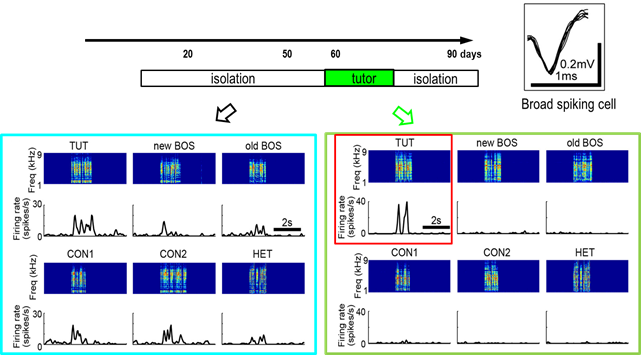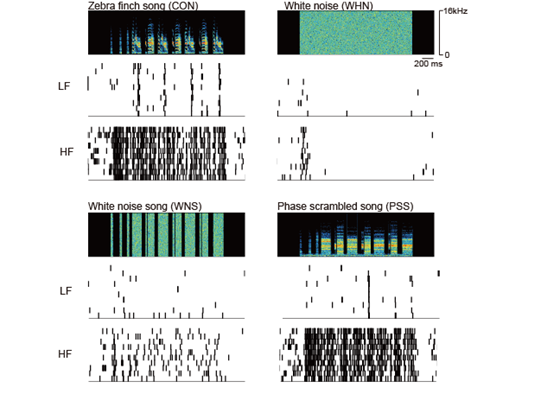FY2015 Annual Report
Neuronal Mechanism for Critical Period Unit
Yoko Yazaki-Sugiyama, Assistant Professor
Abstract
Like humans learning to speak, songbirds learn to sing by hearing what adult birds are singing, preferentially other conspecific birds, during a developmental critical period. In zebra finches, the best-studied model of songbird vocalization, males sing and females do not. Juvenile male zebra finches listen and memorize tutor songs, normally their fathers’ songs, during an early, sensory learning period. Then in a subsequent sensory-motor learning period, they vocalize by themselves and shape their own songs, by matching their songs to the memorized tutor songs. We are especially interested in how auditory experience during sensory learning period shapes the brain circuitry to form a memory of auditory experiences. In addition, we are learning how auditory information is processed to distinguish conspecific songs for referentially learning from them.
1. Staff
- Yoko Yazaki-Sugiyama, Assistant Professor
- Makoto Araki, Postdoctral scholar
- Shin Yanagihara, Staff scientist
- Yuichi Morohashi, Technician
- Mohamed Haytham Mohamed Aly, Graduate Student ( - July, 2015)
- Takashi Kudo, Staff scientist (July, 2015 - )
- Sachiko Blanck, Administrative Assistant
2. Collaborations
3. Activities and Findings
3.1 Forming memory of early auditory experience in zebra finch brain
During early development, juvenile songbirds listen to and form an auditory memory of the adult tutor song. Thereafter, they use this memory to shape their vocalizations in later sensorimotor learning. The auditory association cortex, called the NCM, is a potential storage site for tutor song memory, but no direct evidence has been found for a neuronal representation of this memory in juvenile songbirds. We explored the neuronal substrate for tutor song memory by recording single-neuron activity in the NCM of behaving juvenile zebra finches. We found there are two types of neurons in NCM, different in spike shape and firing rate. Both of the neurons were responsive to many of behaviorally relevant auditory stimulation, including their own song, father’s song or other zebra finch songs, before having adult song experience. In contrast, after being tutored, a subset of one neuron type began to exhibit highly selective auditory responses to the experienced tutor song. Moreover, blockade of GABAergic inhibition, as well as a sleep state, decreased the auditory selectivity to a specific song. Taken together, these results suggest that experience-dependent recruitment of GABA-mediated inhibition shapes auditory cortical circuits, and the tutor song memory is therefore sparsely represented in a subset of auditory cortical neurons.

|
Figure 2: Two distinct neurons in zebra finch auditory forebrain (L3) encode different song information. Sound spectrograph of song stimulation (top), zebra finch song (CON), contentious white noise (WHN), artificial song with white noise syllables (White noise song (WNS)), with phase-scrambled syllable (Phase scrambled song (PSS)), and a raster plot of LF and HF (bottom) to those songs.
|
3.2 Auditory information processing in zebra finch auditory pathway for conspecific voice detection.
Male zebra finches learn songs from their auditory experience during the juvenile period. Among varieties of song they hear, interestingly they preferentially learn from conspecific songs. Songs of zebra finches generally consist of a few acoustical elements, called syllables, which emerge in a stereotyped sequence separated by small silent gaps (~30 ms). However, it is largely unknown how zebra finches detect their species song and proceed to learn from it. We investigated how song auditory information is processed and cognized in the auditory circuit, especially in the primary auditory area, field L (homologous to the mammalian primary auditory cortex) where neurons detect natural sound such as birdsongs out of noise.
In subregion L2a (homologous to layer 4 in the mammalian auditory cortex), where neurons receive thalamic inputs, neurons showed auditory responses to continuous white noise (WHN) as well as to conspecific songs (CON), while neurons in the downstream layer, L3, did not respond to WHN. In L3 we identified two distinct neuronal groups, lower firing neurons (LF) and higher firing neurons (HF). Interestingly, HF responded to WHN when it was presented with the same durations and intervals as syllable elements of CON (white noise song: WNS), while LF did not. In contrast, both LF and HF responded to the CON, even when the frequency phase was scrambled within each syllable. Moreover, when HF was stimulated with same CON syllables repeatedly, they did not response when the silent gaps in between were too short (<5ms), and showed synchronized response to the repeat with decreasing of firing along with repeats when the durations of silent gap were relevant with those in zebra finch songs. These results suggest that within the auditory information processing for song cognition, temporal cues of syllable onset and offset are proceeded independent of the morphology information of songs.

|
Figure 2: Two distinct neurons in zebra finch auditory forebrain (L3) encode different song information. Sound spectrograph of song stimulation (top), zebra finch song (CON), contentious white noise (WHN), artificial song with white noise syllables (White noise song (WNS)), with phase-scrambled syllable (Phase scrambled song (PSS)), and a raster plot of LF and HF (bottom) to those songs.
|
4. Intellectual Property Rights and Other Specific Achievements
4.1 Journals
Nagayama, T., and Araki, M. (2015). Habituation of LG-mediated tailflip in the crayfish. Invert Neurosci, 15(2), 178
4.2 Books and other one-time publications
None
4.3 Oral and Poster Presentations
Invited oral talk at conference
- ‘Chemogenetic control of neuronal activity in songbirds’ Symposium ‘The 9th Avian Model Systems meeting’, Taipei, Taiwan
- Symposium at 93rd Annual Meeting of Physiological Society of Japan, ‘Women Scientists Symposium: The analysis of principles underlying the neuronalnetwork formation in the developmental stage.’ (2016)
- Symposium at 38th Annual Meeting of Japanese Neuroscience Society, ‘The mechanisms of neuronal circuit formation and maturation in the developing brain’ (2015) ‘Learning to be a zebra finch. How does one identify vocalizations of one’s own species?’, Kobe Japan
Oral presentation
- Yanagihara, S., Neural representation of auditory memory in the songbird auditory cortex, June 2015, Hokkaido
- Yanagihara, S. and Yazaki-Sugiyama, Y., Experience-dependent sharpening of neural selectivity to learned birdsongs in the auditory cortex of juvenile songbirds (Abstract) The 38th Annual Meeting of the Japan Neuroscience Society, July. 2015, Kobe
Poster presentation
- Yanagihara, S., State-dependent auditory selectivity for familiar songs in the auditory association cortex of juvenile songbirds, Oct. 2015, Chicago, USA
- Yanagihara, S., Behavioral state control of auditory memory formation in zebra finch song learning, Nov. 2015, Kyoto
- Araki M., Yazaki-Sugiyama Y., Temporal cue cognition provides auditory information for species detection in the auditory forebrain of the zebra finch, Nov. Oct. 2015, Chicago, USA
5. Intellectual Property Rights and Other Specific Achievements
5.1 Patent
None
5.2 Grant
- Neuronal mechanism song learning critical period
JSPS KAKENHI Grants-in-Aid for Scientific Research (C)
PI: Yoko Yazaki-Sugiyama
- Behavioral state control of auditory memory formation in zebra finch song learning.
MEXT KAKENHI, Grant-in-Aid for Scientific Research on Innovative Areas, ‘Memory Dynamism’
PI: Yoko Yazaki-Sugiyama
3. Neural basis for vocal learning in a songbird during the critical period
JSPS KAKENHI Grants-in-Aid for Scientific Research (C)
PI: Shin Yanagihara
6. Organized events (symposia/workshop) and meetings
6.1 Workshop
- Workshop DNC2015: OIST Developmental Neurobiology Course
Co-organizer: Prof. David Van Vactor (Harvard Univ.) and Prof. Ichiro Masai (OIST)
6.2 Seminar
1. Mind the Gap: Neural Coding of Species Identity in Birdsong Prosody
Location: Riken Brain Science Institute
2. Early auditory experience shapes neuronal circuits to form auditory memories in zebra finch song learning.
Location: Division of Behavioral & Neural Biology, Hokkaido University
7. Others
.



